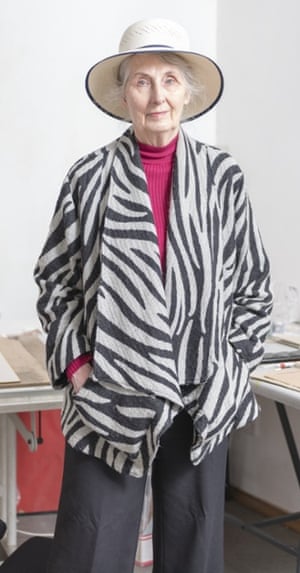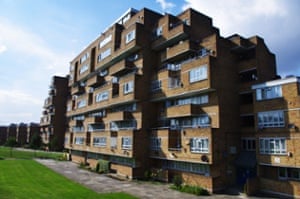In a delightful courtyard garden in south London, a woman in her late 70s is speaking with calm fury. “The steamroller of big finance,” she says, “is being allowed, no, encouraged, progressively to crush out all innovative and creative, locally generated activities.” She is furious because this garden, with its fig, eucalyptus and banana trees, is now considered, in effect, to be a brownfield site, and that it and the houses round it are therefore ripe for redevelopment. With them, everything she has worked for through her life is also under threat.
She is Kate Macintosh, an architect who, working for local authorities in Southwark, Lambeth, East Sussex and Hampshire, designed buildings for public benefit that were at once bold, original and humane. At the age of 28 she designed one of the most remarkable housing developments in the country at Dawson’s Heights in Dulwich, also south London, which amplifies its hilltop site with blocks piling up to 12 storeys high, but which also breaks down into intimate clusters of balconies, and encloses a generous shared garden. Seen from a distance it is dramatic; up close it is protective.

This was for Southwark borough council. For Lambeth, Macintosh designed 269 Leigham Court Road, sheltered housing for the elderly, which has just been listed as a building of historic and architectural importance. Here, two-storey blocks, spread about a gentle slope and connected by a slowly ascending covered walkway, alternate with planted courtyards and gardens. For East Sussex and Hampshire, she designed schools, fire brigade facilities and more sheltered housing. Finally, in private practice with her husband, George Finch, she created an adventure playground in Southampton.
Macintosh was raised in Edinburgh, her parents “committed socialists”, her father a project manager for Scottish Special Housing, an association dedicated to providing good quality social housing. She worked in Scandinavia for a while, then for Denys Lasdun on the early designs for the National Theatre before, realising that this project would take a long time and impatient for experience of building sites, joining Southwark. Throughout, she believed that “one of the generators of our work was the search for social justice”. Others thought this too: there might have been some colleagues “looking for an easy ride, some careerists looking to move on before the mistakes crop up”, but the councils were “institutions that genuinely tried to meet the needs of their constituents”.
She later saw such work of this era widely condemned, for forcing people to live in architects’ utopian dreams, and for creating impersonal and alienating places, but “I never reneged”. Which is not to say that Macintosh was uncritical of the work being put up by local authorities in the 1960s. Some of the larger-scale building of estates was “just dreadful… it was treated as an industrial process with no perception of what it is to be a human being”. She criticised the Greater London council’s formula of dividing estates into towers for small families and lower blocks for larger ones.
A large part of her mission was to counter such sterility. Part of the idea of Dawson’s Heights was that it mixed up different types of home in an ingenious arrangement of interlocking shapes. At the same time there was logic to her decisions. The blocks are tall not only for their spectacular effect, but because the tricky ground conditions required deep foundations, which made height more cost-effective. She then wanted to break up their bulk so they could relate better to the lower houses around. The two main blocks are oriented to make the best use of sunlight, and their highest portions are offset so that they don’t get in the way of each other’s views.

The residents of her works seem to appreciate her efforts: when she revisited Dawson’s Heights for the film Utopia London, a pastor of Caribbean origin told her that she was a genius. Deirdre Shaw, who lives in the Leigham Court Road development, is campaigning to have it renamed Macintosh Court. “This place is a haven,” she says, and invites me listen to its near-silence, despite the closeness of a road. “Like historic almshouses you have a community, you have gardens around it and you have your cells.”
She likes the way that Macintosh placed a shop and a common room to encourage people to meet, but also the way that “this is my space. I don’t have to see anyone if I don’t want to.” Her friend Linda Lee agrees: “I like the silence: you’re surrounded by all this green. The fresh air makes you feel so good. I am one of those people who likes solitude, but you can relate as much as you like. You can choose.”
The construction is plain, what Macintosh called a “restricted range of materials” – concrete block, dark timber, steel railings. It set out to be Lambeth’s first use of coordinated metric dimensions, a concept about which she had “considerable reservations”, but nonetheless gave “a thorough try”. Lee says that “it may not look the greatest thing on the outside, but if you live in it, it works.” Shaw is more positive about the appearance: “The contrast between the trees and birds and gardens and the concrete blocks is really nice: they counterpoint with each other.” Both appreciate the way the open spaces allow their loved ones to roam, Lee’s grandchildren and Shaw’s cat: “It’s pussy paradise,” she says.
Macintosh saw a similar interest in human qualities in the work of Finch, which she first encountered as drawings on the front cover of Architects’ Journal: “I realised he was a fellow spirit before I met him.” Then she contacted Finch, to see if he could give her boyfriend a job. Then they met, and the boyfriend “didn’t last long”. Finch, who died in 2013, was the architect of Cotton Gardens, a development in the London borough of Lambeth of rugged, characterful towers that are now praised by their residents, and low courtyard houses.
One of these contains the garden in which Macintosh expresses her anger at plans to destroy it, to a gathering of local residents and campaigners against comparable proposals elsewhere in the borough. A similar danger to Shaw and Lee’s homes has been stayed, at least for now, by their listing. What really disgusts Macintosh is the complicity of Labour-run Lambeth in wrecking the legacy that they once created, “their eager cooperation with central government in the process of the privatisation of public assets”, their “sham consultations with residents, which are really exercises in hard-sell and bullying”, their “heartless eviction operations”.
“I am old enough to remember the postwar Labour government,” she says, “which at a time when the national debt was 245% of GDP rebuilt the country, doubled living standards and established the welfare state and the NHS… If we could do so much in 1945, when the country was technically bankrupt – what might we now achieve with the political will, in building a more just society?”
Open all references in tabs: [1 – 10]
